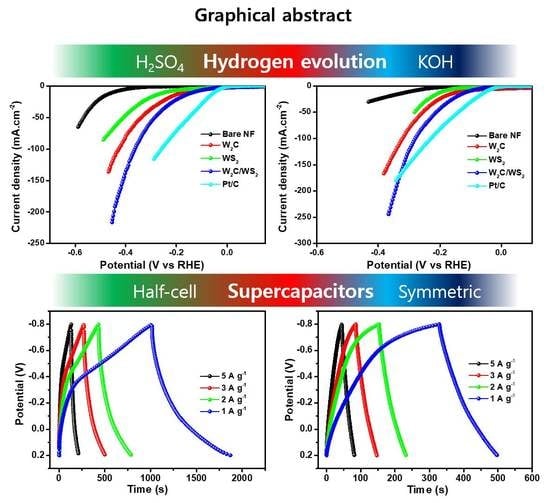One-Pot Synthesis of W2C/WS2 Hybrid Nanostructures for Improved Hydrogen Evolution Reactions and Supercapacitors
Abstract
Share and Cite
Hussain, S.; Rabani, I.; Vikraman, D.; Feroze, A.; Ali, M.; Seo, Y.-S.; Kim, H.-S.; Chun, S.-H.; Jung, J. One-Pot Synthesis of W2C/WS2 Hybrid Nanostructures for Improved Hydrogen Evolution Reactions and Supercapacitors. Nanomaterials 2020, 10, 1597. https://doi.org/10.3390/nano10081597
Hussain S, Rabani I, Vikraman D, Feroze A, Ali M, Seo Y-S, Kim H-S, Chun S-H, Jung J. One-Pot Synthesis of W2C/WS2 Hybrid Nanostructures for Improved Hydrogen Evolution Reactions and Supercapacitors. Nanomaterials. 2020; 10(8):1597. https://doi.org/10.3390/nano10081597
Chicago/Turabian StyleHussain, Sajjad, Iqra Rabani, Dhanasekaran Vikraman, Asad Feroze, Muhammad Ali, Young-Soo Seo, Hyun-Seok Kim, Seung-Hyun Chun, and Jongwan Jung. 2020. "One-Pot Synthesis of W2C/WS2 Hybrid Nanostructures for Improved Hydrogen Evolution Reactions and Supercapacitors" Nanomaterials 10, no. 8: 1597. https://doi.org/10.3390/nano10081597
APA StyleHussain, S., Rabani, I., Vikraman, D., Feroze, A., Ali, M., Seo, Y.-S., Kim, H.-S., Chun, S.-H., & Jung, J. (2020). One-Pot Synthesis of W2C/WS2 Hybrid Nanostructures for Improved Hydrogen Evolution Reactions and Supercapacitors. Nanomaterials, 10(8), 1597. https://doi.org/10.3390/nano10081597






